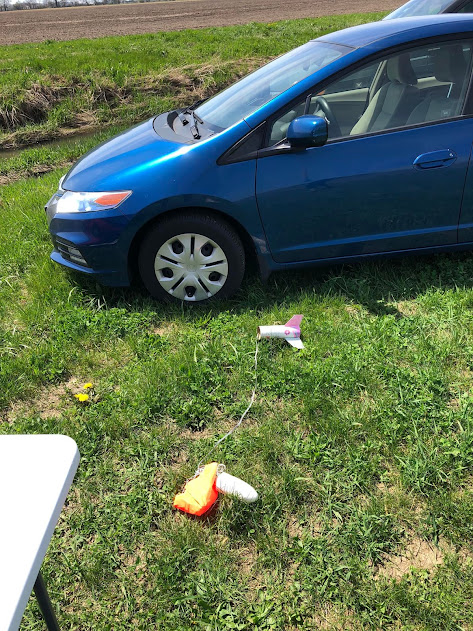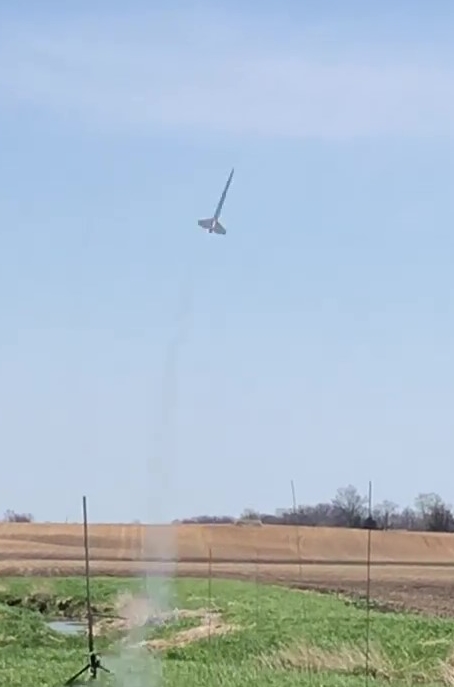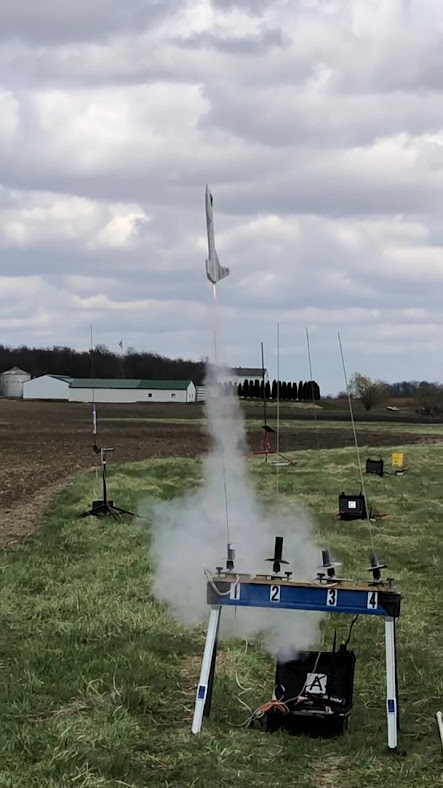Our normal Saturday launch had been moved back a day to allow for The Ohio Cup at the Air Force Museum. This meant a difference of five to ten degrees across the day for us on Sunday, so we really lucked out. As it turned out, we had sunny skies and light winds through much of the day on Sunday. In my case that allowed me to get in ten flights, and if not for a personal tragedy, possibly twelve or more.
As is the norm for me, I spent the week leading up to the launch planning out what rockets I wanted to prep for the weekend. This is more of a time waster than anything else, but it gives me a starting point when the hunt starts in the tote jungle downstairs. I generally pare the list down to 20 or so potential flight victims, with particular attention paid to rockets that had seen numerous years since the last flight or new birds that haven't seen action yet. Sounds like a great system, until you toss in the "Ooh, that one looks cool!" syndrome that seems to rear its head whenever I'm turned loose downstairs. Yeah, my list was largely for naught, but I still managed to pack along a decent mix for the day. First out of the box would be the Estes Marauder coldpower upscale.

This project actually started out as an Estes Polaris upscale, but morphed to the Marauder when Jim Parsons pointed out that the two rockets were identical but for paint and decals. The rocket was a body in white and I was planning on going with the gold, white and blue scheme, which was pretty uninspiring. I'm much more likely to be inspired by neon orange, and I was pretty happy with the way this turned out. This rocket was originally planned as a B6-4 Field staple, so I went with an 18mm motor mount, which gives me impressive B6-4 Field flights on a B6-4, and respectable C6-5 flights in the beans. This one would be a C6-5 flight, because beans.



I set the pad up to take advantage of the tendency for everything to windcock left with the breeze out of the west, and in this situation I pretty much nailed it. After a false alarm to reset the pad, the Marauder rode the C6-5 into the breeze to somewhere around the 600' mark, not quite out over the road. At ejection it hitched a ride with the breeze to a spot in the newly plowed field, just to the left of the mid-power pads. It was a great way to start the day.
Since I last flew my FRW SAAB 372, it had undergone a transformation from primer to fully painted and decaled bird. Owing to the squirrelly nature of the first flight, an E12-6 flight that wound up on a horizontal path almost to the road, I opted for a D12-5 for this flight.
This didn't quite go as planned. I angled the rod into the wind, not quite as much as with the Marauder, but enough to hopefully induce a flight path to the left. The SAAB apparently missed that message. The boost was fairly straight, with never even a head feint to the left. All told, altitude was fairly close to the Marauder and the SAAB was well across the creek when it ejected. As a result, it landed deep in the beans, far enough out that it laid unnoticed for the next few hours despite multiple trips across by other flyers.
I'm not sure how I came to acquire this Estes Mongoose kit, but several years ago I went looking for something to build while I watched a ballgame and pulled it from my stash. I kinda think it may have been a Hobby Lobby clearance find that I couldn't pass up, but whatever the case, I remember being surprised at how quickly it went from started to finished.
In the past I've flown other versions of this design in the Sky-Hi and Scorpion, but those were eBay rescues. This is the first one that was mine from start to finish. Multi-stage kits are always fun, especially when your skin in the game is as thin as mine was with this one. The flight would be a B6-0/B6-6 combination after I caught myself trying to make it a B6-6/B6-0 combo the previous night at home. We had that happen here last winter. Not my bird.
The Mongoose left the pad with a definite leftward lean, staging around the 150' mark and continuing on toward the road to about 754'. The booster came in ballistic, hitting the beans hard enough for me to hear the impact, but without damage. Ejection occurred as the rocket was pointing downward and it recovered several hundred feet off the flightline in the beans. Multi stage flights should always be this much fun, especially since I have a couple of three stage flights waiting in the wings.
I have a checkered past with the Estes D.O.M. birds. They're a great resource for building some cool, seldom seen kits, but the cool factor doesn't make up for the fact that I have about a .500 average when it comes to flying them. My previous D.O.M. Argus II hung itself just out of reach on the telephone lines next to B6-4 Field, then was gone by morning, so this would be something of a redemption flight.

Paint issues plagued this one. Two straight finish coats ruined by orange peel. Despite it all, it turned out looking decent from ten feet. Get closer at your own peril. Decals were a mixture of Interceptor and some stray Centuri leftovers. Not fac-tree, but what is for a D.O.M. bird. It sat through two launch attempts before finally lifting off. C6-5 flight, so I was expecting decent altitude, but it felt like a B6-4 flight. It was straighter than expected and seemed to struggle for altitude to about 553'. The straight flight path meant that it was iffy for the creek, but it cleared it and landed on the other side. Someone else recovered it for me and I was surprised to find that it broke the dorsal fin. Hard beans, I guess.
Oof. On a lighter note, one of the misfires for this rocket gave us the most random comment of the day over a loudspeaker when the LCO said "Ask your doctor if Bill Eichelberger is right for you." Exactly the kind of advice my wife needed back in 1984.
The most interesting flight of the day came next. I was a bit bummed when Estes brought out a Cherokee E that was little more than a Cherokee D with different graphics and colors, so I put together one of my own. Mine was BT-60 based to extend my Cherokee lineup from the BT-5 Cherokee A, but until this flight, I'd never flown it in full livery.
This is another ten foot bird. The big wrap decal cracked and stretched when I was applying it. Such is life in the homemade decal sector. The flight would be on an E12-6, well angled into the wind to attempt recovery on my side of the creek.




True, I adjusted the rod into the wind, just not as much as the angle off the pad seems to show. The Cherokee E took off at an inexplicably steep angle, heading left, as expected, but WAY more left than intended. It also flew behind us. The flight burned for what seemed like an eternity, popped the chute while horizontal, then began a long trip back toward the flightline. Yep, it landed on the right side of the creek. (Correct right, not directional right.) It drifted past the flightline and recovered way out in the beans over the hump. The recovery walk would be long, but again, right side of the creek. When I arrived at the landing spot, something odd immediately caught my eye; a missing launch lug. This explained the extreme angle off the pad. I ran into Mike Rohde on the way back from my recovery journey and showed him what I'd found. Then, on a hunch, I walked over to check the pad to see if the launch lug was anywhere nearby. It was. Right on the rod where it had slid down after coming loose during the launch. If you look at the last launch photo above, you can clearly see the lug on the way back down the rod, silhouetted against the back blackground next to the smoke trail. Interesting and unique, but hopefully not a repeatable error, but never say never.
Next up was an oldie, the FRW Marauder. (Actually, Marauder v. 2. The first one floated off after a C6-5 flight that gave B6-4 Field its name.) This was my first BAR scratch build back in 2001, born out of a Designer's Special that I was less than happy with. The Marauder is beat up, with torn and chipping decals and noticeable scars from hastily repaired flight damage over the last 21 years. It hasn't flown much lately, three times since 2005, and all of them NARAM flights.

C6-5 flight, because on the big field you feed 'em all the onions. As expected, the flight was perfect, a sharp arc to the left off the pad to about 750'. I was slightly worried about the 21 year old elastic shock cord, but it held up well. The Designer's Special parachute, brittle and heavily reefed, also performed well and brought it down to a jarring stop in the soft bean dirt. It bounced and wrapped itself up in the shock cord and parachute, all without damage. The elderly wood glue held up nicely, so all systems are go for the rebuild.
My next flight was a Custom Satellite Drone that I last flew in 2017, but it was one of the rockets that caught my eye when I was prepping on Saturday. I have two of these, but the other one has the fins and ring glued on backwards because I got a little too engrossed with a ballgame I was watching while building it.
This is a unique looking bird from the early days of Custom Rockets. The catalog from this era was loaded with cool kits with a sci-fi edge. They still have some unique designs, but are more of a 3fnc company these days. This would be a C6-5 flight, but it is equally at home on a B6-4 at B6-4 Field. As is the custom here, it went left off the pad to 683', popped the chute as it was tipping over, and began a swinging recovery back to the beans, a mere 50' from the launcher. My sore feet thanked it.
Not sure if it's been mentioned, but I have a thing for Der Red max in any and all forms. My latest was another take at the Mini Max, this one in harvest orange paint. It's the Pumpkin Spice Max. (Ducks and covers.) It was supposed to fly last fall, but decal issues caused it to be delayed. It still has a whole third of the fins undecaled, but that can be hidden with creative photography.

Or not. You'd think I'd pay attention to these things. At any rate, it would be an A10-3T flight, one that I'd be watching closely with the spring flying season at B6-4 Field lurking. Well. based on this flight, there will be no A10-3T flights at B6-4 Field in rockets of this size. Altitude was around 412' with a fairly severe windcock left. Impressive flight, but that's asking for trouble outside of the beans. Recovery is generally handled by streamer, but I found a tiny Estes chute that fit perfectly in the cozy recovery section of this bird. Turned out to be a great pairing as it dropped the Mini Max 150' from the pad. I just don't get it. These should still be all over the hobby store shelves. Great little kits.



Flight #9 would be my Semroc "Centuri Guy" Javelin, a Jay Goemmer inspired build. The Centuri version was one of Jay's early rockets, possibly the first, and after painting my original Semroc offering like the face card, I realized that I liked the black and red version better.


Looking back now, with the aid of ninfinger.org, I'm not sure where Carl came up with the yellow Javelin scheme. All I ever remember was red/black/white. At any rate, I was pretty happy with the final product and had it loaded with a B6-6 for the first flight. It was a truly great engine choice. Big field, so the temptation was strong to go with a C6-7, but I was hoping to recover the rocket in the same county. The flight was wonderfully high, and I think it's possible that it may have crossed into Clarke County airspace at some point, but the breeze brought it back my way, although on the other side of the creek. Mike Rohde picked it up on the way back from flying his Mega DRM on an H128, sparing my feet more agony.


My tenth flight on the day would be the Kopter XK-1 on an E12-6. It would also be my final flight of the day, despite the fact that we still had over an hours worth of flying left in the day. Stopping wasn't my idea. I still had my Semroc Aerobee Hi, The Zorch and mark Kate and Ashley prepped and ready. (Okay, Mary Kate and Ashley had already been passed over for launch earlier in the afternoon due to a nose cone that fit too tight for comfort. I just wanted to say that I had planned on flying it. It was my daughter's rocket from 2001.)
The E12-6 was impressive in this Big Bertha-size bird. It windcocked, brace yourself, left off the pad, but nowhere near as heavily due to the smaller than normal fins. Altitude was excellent, well over 1000', with ejection out over the road. It began riding the breeze back toward the flightline, but along the way there were times when it just looked like it was hanging, not descending at all. Thermals, bah.
It finally landed across the creek, well into the beans not far from where the SAAB 372 was still laying. Since these two flights carried both of my nylon chutes, I donned the muck boots and scouted places to cross the creek. The creek crossing was a simple matter, and I picked up my two rockets and a bonus rocket before crossing back to prep another bird.
But then, tragedy struck, and thankfully there are no photos to share. While heading back to my car I stopped to talk with a couple of the guys while they prepped their next birds. While we were talking, the wind was blowing from behind me and I felt a breeze in an area that should have been breeze proof. Sure enough, my $12 Wal-Mart jeans had suffered a rear closure failure, one that was growing with each move I made and threatening to expose family secrets that I'd spent a lifetime guarding. Luckily for all it wasn't thong day, but my flying day was over.




















































































